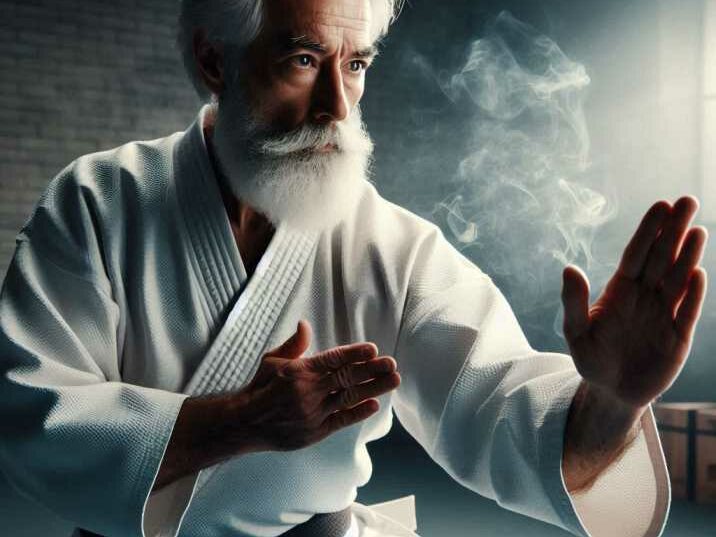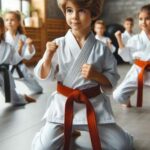Introduction
Table of Contents
The Origins and History of Shotokan Karate
Shotokan Karate was founded by Gichin Funakoshi in the early 20th century. Funakoshi, often referred to as the father of modern karate, brought the art from Okinawa to mainland Japan. Shotokan, named after Funakoshi’s pen name “Shoto,” combines traditional Okinawan martial arts with elements of Japanese martial disciplines.
The history of Shotokan Karate is a story of dedication and evolution. Funakoshi’s teachings emphasized not only physical prowess but also the development of character, humility, and respect. Over the decades, Shotokan has spread globally, becoming one of the most practiced styles of karate.

The Philosophy Behind Shotokan Karate
Shotokan is not just about physical techniques; it embodies a philosophy of life. Practitioners strive for perfection of character, following the Dojo Kun, a set of five guiding principles:
- Seek perfection of character
- Be faithful
- Endeavor
- Respect others
- Refrain from violent behavior
These principles highlight the importance of discipline, respect, and self-control, making Shotokan a holistic practice.
Basic Techniques of Shotokan Karate
Fundamental Moves and Stances
In Shotokan, mastering the basics is crucial. The fundamental techniques include various stances (dachi), strikes (tsuki), blocks (uke), and kicks (geri). Here are some key basics every practitioner should know:
- Stances (Dachi): Zenkutsu-dachi (front stance), Kokutsu-dachi (back stance), Kiba-dachi (horse stance).
- Strikes (Tsuki): Oi-tsuki (lunge punch), Gyaku-tsuki (reverse punch), Kizami-tsuki (jab).
- Blocks (Uke): Gedan-barai (downward block), Age-uke (rising block), Soto-uke (outside block).
- Kicks (Geri): Mae-geri (front kick), Yoko-geri (side kick), Mawashi-geri (roundhouse kick).
Kata: The Heart of Shotokan Karate
Kata are pre-arranged forms that simulate combat against multiple opponents. Each kata has a specific sequence of movements, teaching practitioners to move efficiently and effectively. Some essential katas in Shotokan include Heian Shodan, Heian Nidan, and Tekki Shodan.
Advanced Techniques in Shotokan
Mastering Complex Forms and Combinations
As practitioners progress, they learn advanced techniques that require greater skill and coordination. These include more sophisticated katas such as Kanku Dai and Empi, as well as combination techniques that integrate strikes, blocks, and kicks seamlessly.
Sparring (Kumite)
Kumite, or sparring, is an essential part of advanced training. It allows practitioners to apply their techniques in a controlled, competitive environment. There are various types of kumite, ranging from basic pre-arranged forms to free sparring, each designed to develop different aspects of combat skills.
Training and Discipline in Shotokan
The Importance of Regular Practice
Consistent training is key to mastering Shotokan Karate. Regular practice helps develop muscle memory, improve technique, and build physical fitness. Training sessions typically include kihon (basics), kata (forms), and kumite (sparring), ensuring a well-rounded approach to learning.
Mental Focus and Discipline
Shotokan Karate emphasizes mental discipline as much as physical prowess. Practitioners are encouraged to develop a strong mind, capable of maintaining focus and calm under pressure. This mental discipline is cultivated through meditation, rigorous training, and adherence to the Dojo Kun.
The Benefits of Practicing Shotokan
Physical Benefits
Practicing Shotokan Karate offers numerous physical benefits, including:
- Improved cardiovascular health
- Increased strength and flexibility
- Enhanced coordination and balance
- Weight management and muscle tone
Mental and Emotional Benefits
Beyond physical fitness, Shotokan Karate also provides mental and emotional advantages:
- Stress relief and relaxation
- Enhanced focus and concentration
- Greater self-confidence and self-esteem
- Development of discipline and perseverance
Social and Cultural Benefits
Joining a karate dojo offers social benefits as well. Practitioners become part of a community that values respect, cooperation, and mutual support. This sense of belonging can be especially valuable for children and young adults.
Training Methods for Children
Instructors adapt training methods to suit children’s needs, focusing on making classes fun and engaging while teaching important life skills. Activities might include:
- Basic techniques and kata suitable for their age
- Fun drills and games to improve coordination and balance
- Lessons on the importance of respect and discipline
Shotokan Karate in Modern Day
Relevance and Practice in Today’s World
Shotokan Karate continues to be relevant in modern times, offering valuable skills and benefits in today’s fast-paced world. Many people practice it for various reasons, including self-defense, fitness, and stress relief. It is also a popular choice for those seeking a disciplined, structured activity that promotes personal growth.
Global Reach and Popularity
Shotokan Karate is practiced worldwide, with dojos in almost every country. International organizations like the Japan Karate Association (JKA) and the World Karate Federation (WKF) help maintain standards and organize competitions, ensuring that the art continues to thrive and evolve.
Table of Information
| Section | Description |
|---|---|
| Introduction | Overview of Shotokan Karate |
| History | Origins and development of Shotokan Karate |
| Basic Techniques | Fundamental moves and stances |
| Advanced Techniques | More complex forms and combinations |
| Training and Discipline | The importance of regular practice and mental focus |
| Benefits | Physical, mental, and emotional advantages |
| Shotokan Karate for Kids | Benefits and training methods for children |
| Shotokan Karate in Modern Day | Its relevance and practice in today’s world |
| Common FAQs | Answers to frequently asked questions |
Conclusion
Shotokan Karate is more than just a martial art; it is a way of life that fosters physical health, mental discipline, and strong character. Whether you are a beginner or an experienced martial artist, the journey through Shotokan can be incredibly rewarding. By understanding its history, mastering its techniques, and embracing its philosophy, you can achieve personal growth and enhance your overall well-being.
Frequently Asked Questions About Shotokan Karate
What is the difference between Shotokan Karate and other styles?
Shotokan Karate is characterized by its long, deep stances and powerful techniques. While other styles like Goju-Ryu or Shito-Ryu may focus on different aspects of karate, Shotokan emphasizes strong basics and kata.
How long does it take to earn a black belt in Shotokan Karate?
The time required to earn a black belt varies depending on the individual’s dedication, frequency of training, and the dojo’s standards. On average, it takes about 3-5 years of consistent practice to reach this level.
Can anyone practice Shotokan Karate, regardless of age or fitness level?
Yes, Shotokan Karate is suitable for people of all ages and fitness levels. Dojos often offer classes tailored to different age groups and abilities, ensuring that everyone can participate and benefit.
Is Shotokan Karate effective for self-defense?
While Shotokan Karate is a traditional martial art, its techniques can be effective for self-defense. The training emphasizes quick, powerful strikes and efficient movement, which can be useful in real-world situations.
What equipment is needed to start practicing Shotokan Karate?
Beginners typically need a gi (karate uniform) and a belt. As practitioners advance, they may also require protective gear for sparring, such as gloves, shin guards, and a mouthguard.


